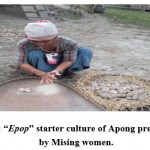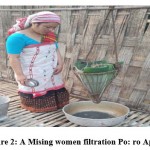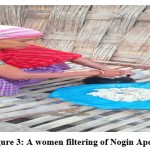How to Cite | Publication History | PlumX Article Matrix
Jelshing Yein 1 , Bhaba Kumar Pegu2*
, Bhaba Kumar Pegu2* , James Sanong2
, James Sanong2 , Nirupam Raj Khanikar3
, Nirupam Raj Khanikar3 and Biswajit Pegu4
and Biswajit Pegu4
1Assamese department, Ujoni Majuli Kherkatia College, Majuli District, Assam.
2Department of Life Sciences, Dibrugarh University, Dibrugarh, Assam,
3Department of Antrophology, Dibruarh University, Dibrugarh
4Department of Chemistry Dibrugarh University, Dibrugarh, Assam
Corresponding Author E-mail: pegu.2010@gmail.com
DOI : http://dx.doi.org/10.13005/bbra/3003
ABSTRACT:
Assam's Mising community is the state's second most populous tribal community. Since ancient times, the Mising tribe has consumed homemade alcoholic beverages. Mising community members, primarily drink two types of homemade alcoholic beverages: Po:ro Apong and Nagin Apong. Various plant ingredients were used in the preparation of the starter culture for such homemade alcoholic beverages as Apong. In Mising rural areas, the ingredients of these plants were also used in traditional ethnomedical practise. The current study documented the Mising community of Majuli District, Upper Assam's traditional ethnomedicinal practise in the homemade alcoholic beverage.
KEYWORDS: Apong; Alcoholic beverage; ethnomedical; Mising; Majuli; Plant
Download this article as:| Copy the following to cite this article: Yein J, Pegu B. K, Sanong J, Khanikar N. R, Pegu B. Traditional Ethnomedicinal Practice in the Homemade Alcoholic Beverage of Mising Community of Majuli District, Upper Assam. Biosci Biotech Res Asia 2022;19(2). |
| Copy the following to cite this URL: Yein J, Pegu B. K, Sanong J, Khanikar N. R, Pegu B. Traditional Ethnomedicinal Practice in the Homemade Alcoholic Beverage of Mising Community of Majuli District, Upper Assam. Biosci Biotech Res Asia 2022;19(2). Available from: https://bit.ly/3xZbVW3 |
Introduction
Homemade alcoholic beverages made from rice are popular among many tribal communities in northeastern India, with many of them having done so since ancient times 1,2. It is also associated with many occasions such as celebrations, ceremonies, festivals, weddings, and even death rituals in the socio-cultural lives of indigenous peoples3. The different processes’ fermentation methods are nearly identical, with the exception that they are derived from different types of plant species used to prepare starter culture4. The Mising people of northeastern India, particularly Assam and Arunachal Pradesh, have a traditional homemade alcoholic beverage called “Apong” that is a part of their cultural, social, and religious life. According to various authors, different plants were reportedly used in the production of homemade alcoholic beverages’ starter culture in northeastern India. In the year 2021, this study aims to implement the traditional ethnomedical practise of making homemade alcoholic beverages in the Mising community of Upper Assam, Assam.
Material and methods
Study area
A field survey was conducted for three months (September-December 2021) in villages and rural areas in the Majuli district, Upper Assam. The region was selected based on the available information on the distribution of traditional recipes for homemade alcoholic beverages. The information was collected primarily from rural households involved in the manufacturing process of homemade alcoholic beverages.
Result and discussion
Observations
The following information was collected during the survey work during the survey period. Also mentioned are the scientific name and the local names (in Mising) of plants and various other ingredients used in the homemade preparation of alcoholic beverages. Table (1) shows the number of plants and their parts used to make homemade liquor starter culture cakes. All species were collected from nearby villages and forests as wild plants used by these tribes in the Majuli, district. Upper Assam. A total of 21 plant families were recorded during the investigation periods; these are Poacea, Moracea, Costaceae, Zingiberaceae, Umbelliferae, Schizeaceae, Gentianaceae, Myrtaceae, Solanaceae, Scrophulariaceae, Bromeliaceae, Lamiaceae, Laurels, Lamiaceae, Dogbanes, Rutaceae, Thelypteridaceae, Asteraceae, Lamiaceae, and Piperaceae. Study periods we have visited more than 20 villages households they have similar kinds of plants species used processing homemade alcoholic beverages. We also documented these plants’ ethnomedical practice in a rural area for a decade (Table 1). Generally, these phytonutrients are thought to improve the quality of the product and are used in the preparation of “epop”. This study suggests that different plants species ingredients are used to meet different needs for improving the final product. However, some ingredients are used as preservatives, while others are used as an antioxidant, antimicrobial agents, and fragrances5. Two types of the homemade alcoholic beverage of Mising tribes, Po: ro Apong and Nogin Apong. Po: ro Apong: Po: ro Apong is the most popular homemade alcoholic beverage in Assam and Arunachal Pradesh. Methodology of Po: ro Apong and Nogin Apong extraction process briefly described the 1, 4, 6. In Assam, different ethnic groups variety of plants ingredients used for processing starter culture cake of homemade alcoholic beverages; they believed these plants ingredients provide the fragrance, flavor, and color of alcoholic beverages7. Indigenous fermented food is prepared utilizing different substrates and non-pathogenic microorganisms as starter and processing culture to be sold at the local markets for local consumption. Probiotic bacteria play a major role in the production of most of the fermented foods and beverages8. Indigenous fermented foods are an integral part of diet of the ethnic tribes in the Himalayan belt of India, being the oldest and most economic methods for development of a diversity of aromas, flavors, and textures, as well as food preservation and biological enrichment of food product by the manipulation of different microbial population9.
 |
Figure 1: “Epop” starter culture of Apong preparation by Mising women. |
 |
Figure 2: A Mising women filtration Po: ro Apong. |
 |
Figure 3: A women filtering of Nogin Apong. |
Table 1: Name of plant species commonly used in preparation of “Epop” starter culture of Apong.
| S/No | Scientific name | Family | Local name | Plant part used | Ethno medical used (in villages people) |
| 1 | Oryza sativa L. | Poaceae | Dhan | Rice grains | Used as food |
| 2 | Artocarpus heterophyllus Lamk. | Moraceae | Kathal
|
Leaves | Used in anti-bacterial and fungal properties. |
| 3 | Costus speciosus J. E. Sm.
|
Costaceae | Jomlakhuti | Leaves | Used as jaundice, antioxidant |
| 4 | Zingiber officinale Rosc. ( | Zingiberaceae | Ada | Bulb | Used in Diarrhea, loss of appetite, infections, cough, and bronchitis |
| 5 | Centala acciatica
|
Umbelliferae | Bor Manimuni | Whole plant | As used apetiser, Liver function |
| 6 | Hydrocotyl rotundifolia
(Roxb); |
Umbelliferae | Soru-manimuni | Whole plant | Used as apetiser, and against
dysentery |
| 7 | Lygodium japonicum (L)
|
Schizeaceae | Kopou dhekia | Leaves | Used as Root and leaves possess
medicinal property |
| 8 | Swertia chirata (Buch-Hem)
|
Gentianaceae | Chirota tita | Leaves and Burk | Used as Bitter tonic, liver disorders, malaria, and diabetes |
| 9 | Psidium guajava L. | Myrtaceae | Modhuri | Leaves | Used as lower blood sugar, and digestive System |
| 10 | Solanum torvum Sw. | Solanaceae | Tita-Bhekuri | Leaves | Used as reproductive problems treatment, wounds, and tooth decay
|
| 11 | Scoparia dulcis L. | Scrophulariaceae | Bon-dhuniya | Leaves | Used stomach problems, diabetes, jaundice, fever, kidney stones, skin disease, reproductory issues, and pile
|
| 12 | Ananas comosus | Bromeliaceae | Anaras | Leaves | Used as skin injuries |
| 13 | Leucas aspera | Lamiaceae | Dronbon | Whole plants | Used as treatment of dysentery, urogenital disorders, piles, and fever
, |
| 14 | Cinnamomum verum | Laurels | Dalchini | Leaves | Used as anti-diabetic, antioxidant, and Jaundice effects
|
| 15 | Occimum sunctum | Lamiaceae | Tulsi | Leaves | Used as a diarrhea, fever, cough, dysentery and eye disease
|
| 16 | Rauvolfia serpentina | Dogbanes | Arachoritita Sarpagandha | Leaves | Effective treatment for hypertension and Snake bites
|
| 17 | Murraya koenigii
|
Rutaceae | Narosingh | Whole plant | Used as digestives, Fever and appetizers in Indian cookery
|
| 18 | Cyclosorus dentatus | Thelypteridaceae | Bihlongoni | Leaves | Used as diarrhea, wound hill and possess
medicinal property
|
| 19 | Ageratum conyzoides | Asteraceae | Gendali-bon | Leaves and bark | Used against stomach pain, dysentery and diarrhea
|
| 20 | Vitex negundo | Lamiaceae | Posotiya | Leaves and bark | Used as muscle aches and joint pains, possess
medicinal property
|
| 21 | Piper longum | Piperaceae | Jaluk | Leaves | Used as a cough, fever, antioxidant, anti-inflammatory and muscle aches
|
Conclusion
Alcoholic beverages, particularly Misings’ Apong, are often thought to have medicinal properties by them and are primarily consumed as a relaxant. It’s also used as an offering in religious ceremonies, crisis rites, and other celebrations, so it’s a drink with cultural significance in Mising society. However, the drink is only brewed in households, and no attempt has been made to commercialise it. The recipe for the drink is a gendered affair, and it is usually only known by the women in the community. There is variation in the brewing process in different regions due to the lack of a standard procedure for the knowledge of the recipe being passed down orally for generations. As a result, a thorough scientific examination of the ingredients and the brewing process will standardise the process. The scientific method will ensure that the right amounts of ingredients are used and that the medicinal properties of the ingredients are preserved. The beverage can then be used for commercial production once the procedure has been formally documented in a scientific manner. Commercialization of the drink could result in revenue that could be used for Mising society’s overall development as well as provides employment for the community’s youth.
Acknowledgment
The authors are thankful to the Department of life sciences, Dibrugarh University, Assam and for the technical support and facilities for carrying out this work.
Conflict of Interest
The authors have no conflict of interest.
Funding Source
There is no funding sources.
Reference
- Deka D, and Sarma, G.C. Traditionally used herbs in the preparation of rice-beer by the Rabha tribe of Goalpara district, Assam. Indian Journal of Traditional Knowledge, (2004) 9(3), 459-462.
- Deori, C., Bengum, S.S. and Mao, A.A. Ethnobotany of sujen, a local rice beer of Deori tribe of Assam. Indian Journal of Traditional Knowledge (2007), 6 (1), 121-125.
- Ghosh, C. and Das, A.P. Preparation of rice beer by the tribal inhabitants of tea gardens in Terai of West Bengal. Indian Journal of Traditional Knowledge, (2004), 3(4), 374-382.
- Jeyaram, K., Singh, W.M., Capece, A. and Romano, P. 2008. Molecular identification of yeast species associated with ‘Hamei’- A traditional starter used for rice wine production in Manipur, India. International Journal of Food Microbiology, (2008), 124:115–125.
CrossRef - Tiwari S C and Mahanta D, Ethnological observation on the fermented food products of certain tribes of Arunachal Pradesh, Indian Journal of Traditional Knowledge,(2007), 6(1), 106-110.
- Kardong D, Pegu B K, Guha B G. Evaluation of Efficacy of the Microbial Consortium for Fermentation of Alcoholic Rice Beverage amongst Mising tribe of Assam, India. Current Trends Pharmaceutical Research, (2017), 4(2):6-17.
- Kardong D, Deori K, Sood K, Yadav R N S, Bora T C and Gogoi B K. Evaluation of Nutritional and biochemical aspects of Po:ro apong (Saimod)- A homemade alcoholic rice beverage of Mising tribe of Assam, Indian Journal of Traditional Knowledge, (2012), 11(3), 499-504.
- Mokoena MP, Mutanda T, and Olaniran AO.Perspectives on the probiotic potential of lactic acid bacteria from African traditional fermented foods and beverages. Food and Nutrition Research, (2008), 60(1), 29630.
CrossRef - Rawat KA, Kumari S, Kumar R, and R. Gehlot. “Traditional fermented products of India.” International Journal of Current Microbiology and Applied Sciences, (2018), 7(4), 1873-1883.
CrossRef

This work is licensed under a Creative Commons Attribution 4.0 International License.





